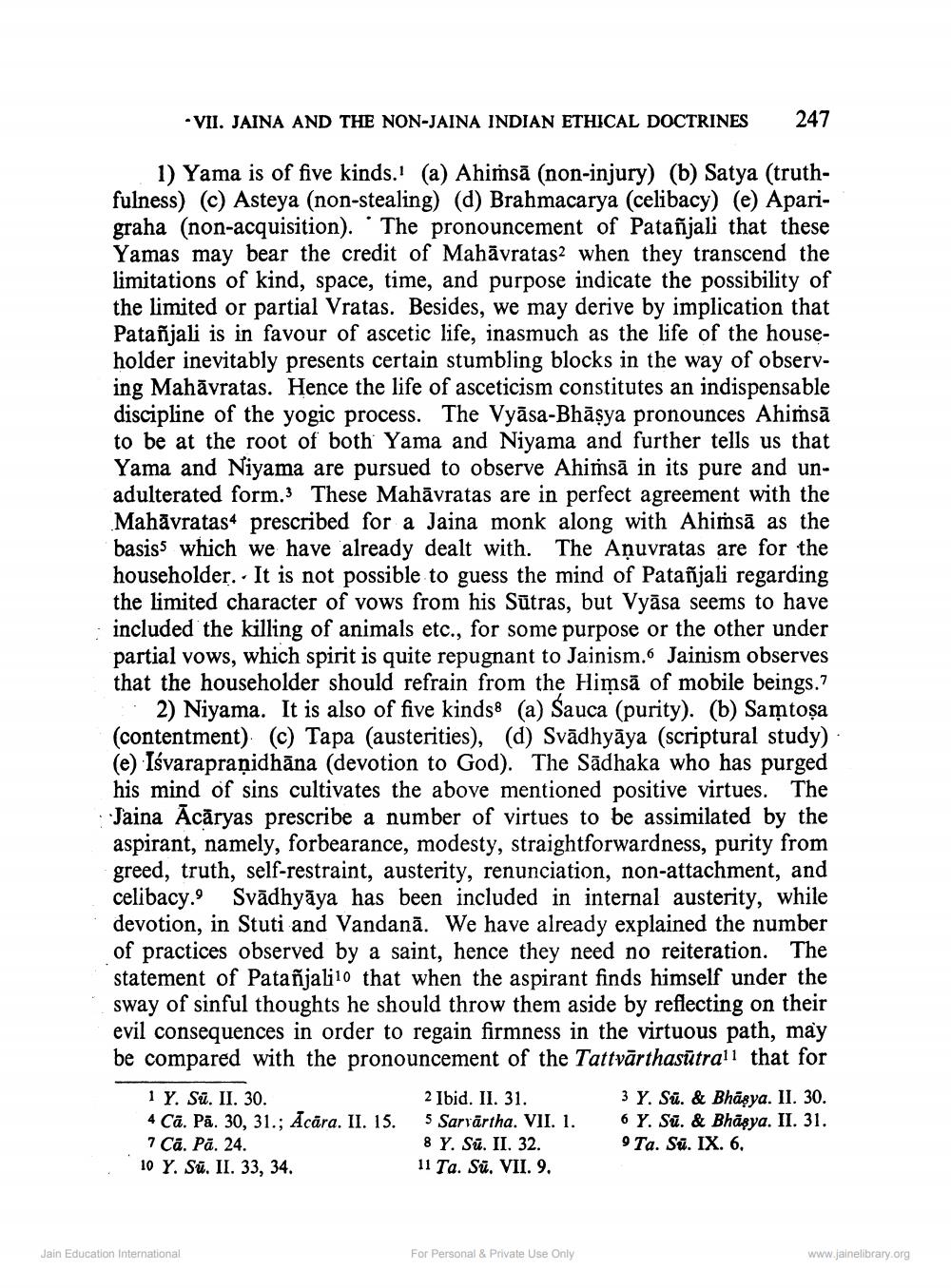________________
- VII. JAINA AND THE NON-JAINA INDIAN ETHICAL DOCTRINES
247
1) Yama is of five kinds. (a) Ahimsă (non-injury) (b) Satya (truthfulness) (C) Asteya (non-stealing) (d) Brahmacarya (celibacy) (e) Aparigraha (non-acquisition)." The pronouncement of Patañjali that these Yamas may bear the credit of Mahāvratas2 when they transcend the limitations of kind, space, time, and purpose indicate the possibility of the limited or partial Vratas. Besides, we may derive by implication that Patañjali is in favour of ascetic life, inasmuch as the life of the householder inevitably presents certain stumbling blocks in the way of observing Mahāvratas. Hence the life of asceticism constitutes an indispensable discipline of the yogic process. The Vyāsa-Bhāşya pronounces Ahimsā to be at the root of both Yama and Niyama and further tells us that Yama and Niyama are pursued to observe Ahimsā in its pure and unadulterated form.3 These Mahāvratas are in perfect agreement with the Mahāvratas4 prescribed for a Jaina monk along with Ahiṁsā as the basiss which we have already dealt with. The Aņuvratas are for the householder. It is not possible to guess the mind of Patañjali regarding the limited character of vows from his Sūtras, but Vyāsa seems to have included the killing of animals etc., for some purpose or the other under partial vows, which spirit is quite repugnant to Jainism.. Jainism observes that the householder should refrain from the Himsă of mobile beings.7
2) Niyama. It is also of five kinds8 (a) Sauca (purity). (b) Samtoșa (contentment). (c) Tapa (austerities), (d) Svādhyāya (scriptural study) (e) Isvaraprasidhāna (devotion to God). The Sādhaka who has purged his mind of sins cultivates the above mentioned positive virtues. The Jaina Ācāryas prescribe a number of virtues to be assimilated by the aspirant, namely, forbearance, modesty, straightforwardness, purity from greed, truth, self-restraint, austerity, renunciation, non-attachment, and celibacy. Svādhyāya has been included in internal austerity, while devotion, in Stuti and Vandanā. We have already explained the number of practices observed by a saint, hence they need no reiteration. The statement of Patañjaliio that when the aspirant finds himself under the sway of sinful thoughts he should throw them aside by reflecting on their evil consequences in order to regain firmness in the virtuous path, may be compared with the pronouncement of the Tattvārthasūtrall that for
1 Y. Sú. II. 30. 4 Ca. Pā. 30, 31.; Ācāra. II. 15. 7 Ca. Pā. 24. 10 Y. Sū. II. 33, 34.
2 Ibid. II. 31. 5 Sarvārtha. VII. 1. 8 Y. Sū. II. 32. 11 Ta. Sů. VII. 9.
3 Y. Sú. & Bhasya. II. 30. 6 Y. Sü. & Bhäşya. II. 31. 9 Ta. Su. IX. 6.
Jain Education International
For Personal & Private Use Only
www.jainelibrary.org




